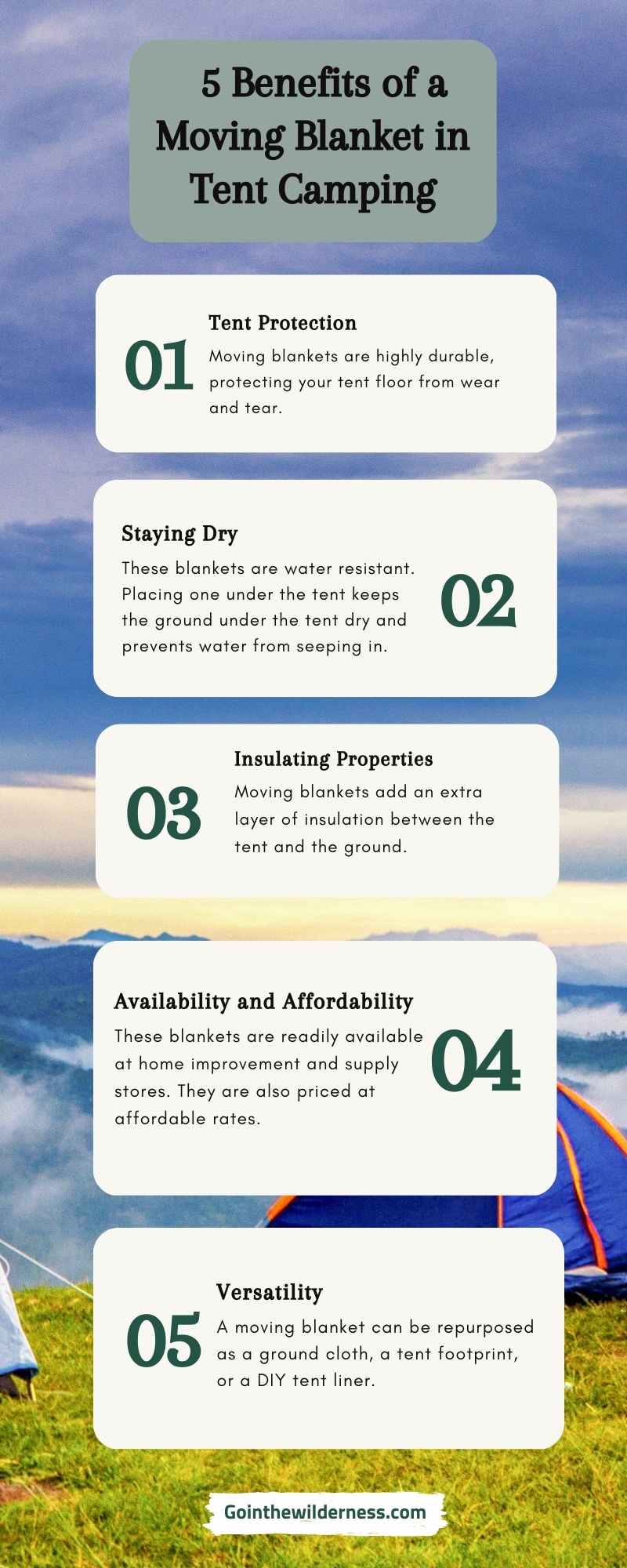As a bushcrafter and camper, you’ll know the story: getting cold and wet while camping in a tent is a nightmare! But don’t fear, moving blankets are a great solution. Attached to the floor of your tent, moving blankets add a layer of insulation and protection while you camp.
Besides keeping you warm and dry, there are many more benefits to using a moving blanket. In this article, you’ll get to know those benefits—and you’ll also get a quick guide to setting a moving blanket up effectively. Let’s go!
The Benefits of Moving Blankets
When you’re out camping, you can use a moving blanket to cover the floor beneath your tent. Think of a moving blanket as a big, padded quilt that you attach to your tent’s underbelly. There are various advantages to using a moving blanket during camping, so let’s go through them now!

Tent Protection
Firstly, moving blankets are highly durable, protecting your tent floor from wear and tear. Most tents are made only out of lightweight nylon and ripstop, which can be prone to damage if you camp on rough, uneven terrains or in harsh weather conditions. A moving blanket solves that problem, adding an extra layer of tent floor protection that is thick, durable, and resistant to water and stains. Thanks to this added protective layer, you’ll protect your tent and save money on repairs and replacements in the long run.
Staying Dry
Another benefit of moving blankets is that they’re highly water resistant. Place one under your tent or bivy bag, and you’ll keep the ground under dry, as well as preventing water from seeping in. That way, you’ll enjoy a nice and dry night’s sleep! So, if you’re going out camping in wet or humid conditions, e.g. in a place known for its high rainfall or humidity, we’d recommend that you take a moving blanket with you. Don’t let wet and muddy ground ruin your trip!
Insulating Properties
As well as keeping you dry, moving blankets can keep you warm when camping. They add an extra layer of insulation between your tent and the ground, which can be especially handy if you’re only using a thin sleeping pad. So if you’re going camping in the cold and you love to stay warm for a snug night’s sleep, a moving blanket will be a great addition to your kit. Another advantage: the insulating qualities of a moving blanket will also help limit the accumulation of condensation and moisture in your tent overnight.
Availability and Affordability
The next advantage of moving blankets is that they are very readily available—you can find them at home improvement stores, moving supply stores, and even at Amazon and Walmart. What’s more, they’re priced at affordable rates, too, so you’re likely to find one that fits your budget! This is especially so if you compare moving blankets to tent footprints and Tyvek ground cloths. The latter are made from more expensive, specialized materials and are mostly only sold by more expensive stores specializing in outdoors and camping. If you want to get the job done at a fraction of the price, a moving blanket may be the best choice for you.
Versatility
Finally, a moving blanket can be repurposed as a ground cloth, a tent footprint, or a DIY tent liner. To use your moving blanket as a tent footprint, you can cut it to the same size as your tent floor and place it beneath the tent. This will help protect your tent’s floor from water, mud, and other elements. Alternatively, you can repurpose your moving blanket as a DIY tent liner: simply hang the moving blanket inside your tent using cords or bungee cords. The result? A tent that’s kept insulated and warm—meaning an even cozier night’s sleep for you!
Drawbacks to Consider
As you now know, moving blankets bring multiple advantages during camping. However, before you go out and buy one, it’s important that you consider the drawbacks, too—here is an overview for you:
- Noise: Due to the materials they’re made of, moving blankets can make rustling noises when moved, which might be irritating if you’re a light sleeper.
- Bulk: If you’re looking to minimize the weight and size of your pack, a moving blanket might not suit you.
- Functionality: Moving blankets are sometimes not as durable or water resistant as other options, like tent footprints or Tyvek ground cloths. (But remember that the latter are more expensive!) Also, as with many types of kit, a moving blanket can only get you so far if you’re camping in very extreme conditions e.g. highly rocky terrain.
For most bushcrafting trips, the benefits of moving blankets far outweigh these minor drawbacks. For most people, moving blankets are a simple and effective option that makes camping a whole lot more comfortable and fun!
How to Set up a Moving Blanket

So, now you know the pros and cons of moving blankets, let’s learn how to set them up! First, lay your moving blanket on the ground where you plan to put your tent. Next, set up your tent on top, making sure that your blanket is fully covering your tents floor. This will ensure protection against the elements, water, and mud. Finally, secure the moving blanket in place by using cords or bungee cords to tie it down to the tent. This will help keep the blanket in place and ensure it provides the maximum amount of protection to your tent floor.
…And that’s a wrap! A moving blanket, as you’ve learned, won’t only protect your tent from damage—it’ll also protect you from the cold and prevent water from getting into your tent. Priced at such affordable rates, moving blankets are a very sensible addition to any camper’s kit. Consider getting a moving blanket and trying it out for yourself—it’ll be certain to enhance your next camping experience!
I am Bruno. Navigating the urban rush by day, I find peace under the stars by night. Alongside my loyal companion and co-adventurer Lilith, we explore the balance between city life and nature’s embrace. Through writing and films, I delve into bushcraft and the wild’s allure.
GointheWilderness is my bridge between these two realms, guiding you to reconnect with your innate wilderness.
Eden is here and now; join us in rediscovering it.

